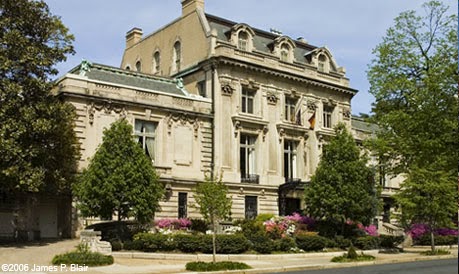The Mouncey Checkerboard Rug - Damascus?
From the collection of Sir George Mounsey, KCMG., CB, CBE (1879-1966) and was published in Hand Woven Carpets by A.F. Kendrick and C.E.C Tattersall, New York, 1922, Vol. II, pl. 47. Kendrick and Tatersall as it is called still stands up well today as the best of British Rug literature in the days before Hali magazine.
The execution of the corners are an interesting clue. It is not the fully unresolved corner that we expect to see in village or Anatolian rugs. It shows a strong indication of a cartoon and or supervised workshop. It is obviously not what we expect from a royal workshop but still it is more refined than a simple village weaver would weave on her own.
The Checkerboard name comes from a Panel Repeat which in this case is a 9 Panel Repeat. Here we can see that this rug repeats 3 times accross and 3 times up and down.
Notes from the Christie's Catalog:
A CHEQUERBOARD RUG
PROBABLY DAMASCUS, SYRIA, 16TH CENTURY
Price Realized
£80,500 Set Currency
($133,711)
Estimate
£60,000 - £80,000
($99,360 - $132,480)
Sale Information
SALE 1519 — ORIENTAL RUGS & CARPETS 8 April 2014 London, King StreetLot Description
A CHEQUERBOARD RUG
PROBABLY DAMASCUS, SYRIA, 16TH CENTURY
Light even wear, corroded black, scattered repairs, selvages replaced, minor loss to each end
6ft.1in. x 4ft.7in. (184cm. x 140cm.)
Saleroom Notice
Please note that this carpet was formerly in the collection of Sir George Mounsey, KCMG., CB, CBE (1879-1966) and is listed as being in his collection when it was published in A.F. Kendrick and C.E.C Tattersall, Hand Woven Carpets, New York, 1922, Vol. II, pl. 47. It was sold at Sotheby’s London, 15 October 1943, lot 160 and was sold subsequently at the same sale rooms on 20 March 1959, lot 35.
Literature
Ulrich Schürmann, Orientteppiche, Wiesbaden, 1965, p.30
Friedrich Spuhler, Hans Konig and Martin Volkmann, Old Eastern Carpets: Masterpieces in German Private Collections, Munich, 1978, pl.3, pp.34-35.
Exhibited
Alte Orientteppiche, the Staatliche Museum fur Volkerkunde, Munich, 1978
Lot Notes
Very few chequerboard or compartment carpets have survived and yet they are some of the most recognisable of all classical carpets with their limited palette of vermillion, light blue and green and the bold repeated design of stars with radiating cypresses enclosed by corner angles. There are currently only approximately thirty known examples of these beautiful prismatic rugs and of these Friedrich Spuhler cites that only four are organised in the 3 x 3 hexagon format of the present rug (Friedrich Spuhler, ''Chessboard' Rugs', Oriental Carpet & Textile Studies II: Carpets of the Mediterranean Countries 1400-1600, London, 1986, p.261). The attribution of Damascus as a place of origin is one that dates back to the carpet scholarship of the early 20th century when these rugs tended to be referred to as Damascus or Damascene rugs. However, the attribution is far from secure and has been hotly debated ever since, and the alternative suggestions of Cairo, Rhodes, the Anatolian Adana Plain and, more recently, the Aqqoyunlu Turkmen (Jon Thompson, 'Carpets in the Fifteenth Century', Carpets and Textiles in the Iranian World 1400-1700, Oxford, 2010, pp.31-57) have all been mooted. For a thorough discussion of the subject please see Robert Pinner and Michael Franses, 'The Eastern Mediterranean Carpet Collection in the Victoria and Albert Museum', Hali Vol.4 No.1, pp.37-52.
Visually, in the limited palette and kaleidoscopic geometry of their designs, the chequerboard rugs appear to be near relations of Mamluk carpets (see lot 20 in the present sale) and yet there are a number of important technical differences that would appear to rule out the same workshops of origin. The structure of the chequerboard carpets is thick, heavy and rigid, quite unlike the supple and lustrous quality of the Mamluk carpets, the wool is Z spun rather than S spun Mamluk weavings and a different type of red dye is used in each type. Mamluk carpets use lac which is a red dye created from scale insects similar to cochineal and the Chequerboard group use the plant-dye madder (Mark Whiting, 'The Red Dyes of some East Mediterranean Carpets', Hali ibid., pp55-56). Spuhler suggests that it seems more likely that they are related to another group of visually similar weavings, the so-called Para-Mamluk rugs, which have Z spun wool and are nearly identical in structure to the Chequerboard rugs (Friedrich Spuhler, ibid., pp.265-268).
The present carpet relates closely to the McMullan Chequerboard rug in the Metropolitan Museum of Art, inv no. 69.267 in its organisation of the 3 x 3 hexagon and cartouche and rosette border, but differs in its coloration (Joseph V. McMullan, Islamic Carpets, New York, 1965, pl.3, pp.26-27). The present example has sky blue medallions with red centres which create the impression of being able to look through the centre of the repeated hexagon lattice like a jali screen, whereas the McMullan rug has medallions of alternating colours with the contrasting medallion's colour in its centre. In spite of their rarity, which would suggest a relatively small and short-lived production, a number of these carpets appear in portraits and genre scenes by Italian and Dutch painters from the late 16th century and throughout the 17th century (John Mills, 'Carpets in Italian Paintings', Oriental Carpet & Textile Studies II: Carpets of the Mediterranean Countries 1400-1600, London, 1986, pp.117-118. One of the most effective of these paintings is Gabriel Metsu's 1659 work, A Musical Party, which is currently being exhibited alongside the McMullan Chequerboard rug in the Metropolitan Museum of Art's exhibition Carpets of the East in Paintings of the West.

.jpg)











































